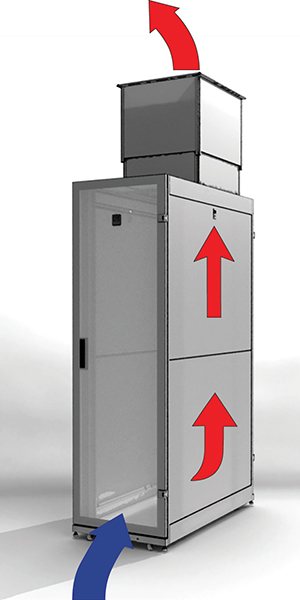Founded in 1998, Xfernet delivered enterprise-level hosting and managed internet services to small and medium businesses. Today, the business has evolved into a robust colocation, hosting and managed services provider with facilities in Los Angeles; Chicago; Ashburn, Va.; New York City, London and Dublin; each with onsite staff 24x7x365.
Business Challenge
After significant growth, the company needed to migrate its Los Angeles facility into a 14,000 square foot data center space with shallow raised floors, low ceilings and limited footprint for new cooling equipment. The uncontained hot/cold aisles were limiting their ability to support increasing demand for higher rack densities. The convenient, but inefficient solution, of adding more air conditioning was not an option for Sam Scott, Xfernet’s CEO and project lead.
"We were growing and needed to support additional clients, but it was a struggle to maintain equipment operation with that setup. I wasn’t OK with just buying more cooling,” Scott explains.
Strategy
Scott was determined to create a new data center solution that would support higher rack densities within acceptable operational temperatures. Scott approached the problem from two perspectives:
1. Increased rack density: At current 200 watts per square foot, the company needed to reduce the physical white space of the data center in order to achieve higher rack densities. The white space was then constrained to 10,000 square feet to enable double the rack density at 4 - 5 kW per cabinet (20 square feet per rack)
2. Cooling: At those higher rack densities, Scott knew that adding more air conditioning to the room was not an effective option. He needed to find a solution that would provide ideal airflow to cool each rack despite the fact that the room had low drop ceiling and shallow raised floors, which limited the amount of airflow volume into the room.
I was determined I was going to find someone out there thinking about this problem in a different way. Without question, this has been the case,” Scott says.
Solution

In searching for a solution that would approach cooling more effectively within the architectural limitation of the facility, Scott learned about Chatsworth Products (CPI) and CPI Passive Cooling® technology, which had been introduced to the market as a game-changer in data center cooling. Passive Cooling completely segregates hot and cold air, and can be applied at the cabinet or aisle level, providing increased equipment cooling performance in all elements of the data center mechanical plant, thereby reducing overall energy costs.
In an existing space, cabinet-level Passive Cooling is typically the ideal solution, as it allows for airflow to be effectively managed regardless of architectural constraints. CPI’s F-Series TeraFrame® Cabinets with Vertical Exhaust Ducts were the selected solution.
F-Series TeraFrame Cabinets are highly configurable and functional racks, providing an industry-leading 3,000 lb (1360 kg) load rating and compatibility with several airflow, cable and power management accessories. This made the cabinets the perfect solution for Xfernet’s present and future needs.
As Figure 1 shows, Passive Cooling is provided through the patented Vertical Exhaust Ducts attached on the cabinets. The ducts channel the hot exhaust air out of the cabinet and up into the drop ceiling, segregating the hot air out of the room, and ducting it back passively into the Computer Room Air Conditioner (CRAC) units. The cooled air from the CRAC units is then redistributed under the floor, into the room and through the racks. This cools the equipment without the need to overprovision the room, drastically reducing cooling costs.
Results
Xfernet was able to double rack densities and reduce its Power Usage Effectiveness (PUE) rating to 1.47, mainly because of the efficiencies from CPI Passive Cooling, according to Scott.
“We saw the improvement immediately once we implemented the cabinets. It allowed us to fully service our clients. Clients pay per footprint of the cabinet space. When the limitation is compute power and ability to cool that power—if you can’t support that—they’ll look elsewhere,” Scott explains.
The ability to have energy-efficient cooled air in its data centers allowed Xfernet to keep ideal temperatures on doubled rack densities while still having room for growth. While some of their custom deployments are supporting up to 10 kW without cooling issues, CPI Passive Cooling allows for densities up to 30 kw per cabinet.
"For us this set up was a dream come true,” Scott says. “We couldn’t operate at the level we do without these cabinets; hands down.”